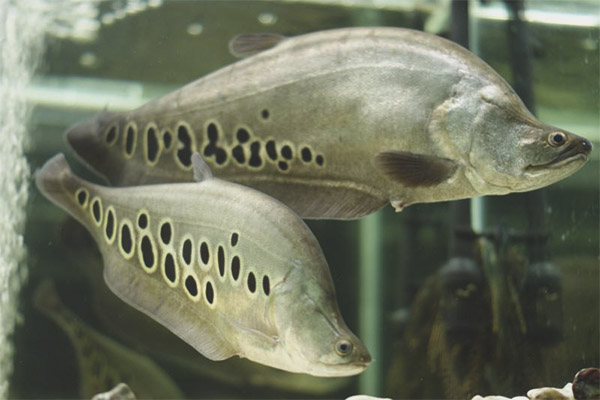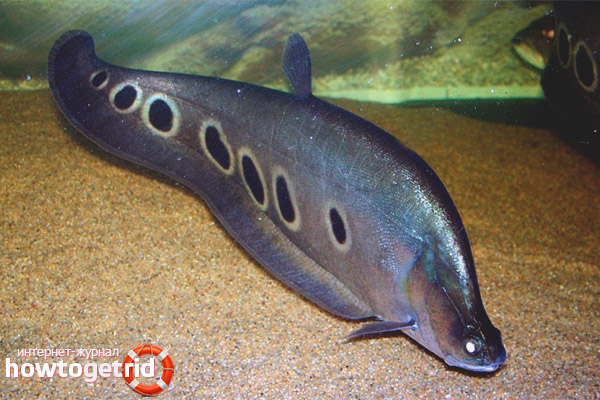The content of the article
When professional aquarists hear the word "knife", they do not see cold weapons, but a kind of fish. The family was first described in 1831; on this day, water pets are eaten and maintained to decorate the aquarium. Fish are famous for their aggressiveness, so they usually swim one at a time. But if you pick a pet good-natured temperament, it is quite possible that it will be possible to create a common beautiful aquarium. However, we will not look forward, consider the main characteristics in more detail.
Description
The name of the family was due to the unusual appearance of individuals of this species. If you look closely at the fish, then it will seem similar to the blade of a knife.
The tail fin merged with the lower one, creating a single cascade that resembles a knife. Individuals move precisely because of this structure.The scales are small in size, with black spots all over the body.
There are albino fish in nature and aquarism; they have white spots on the sides of the hull. Under natural conditions, members of the family can grow up to 1 m. In length with a mass of 5-10 kg. However, in the aquarium conditions, the growth of pets is 25-50 cm, so it requires a decent amount of reservoir.
Fish of this breed group is considered long-liver. If she is provided with all the conditions for a comfortable life, then she will live 10-15 years.
Otherwise, members of the family are called chitals, they spend most of their waking hours on the bottom. Rarely climb into the middle or upper lane, except that the pet needs to breathe atmospheric air or fortify itself with food floating on the water surface.
All fish from the family of the panthers prefer to stay awake at night. But if the fish adapts to the aquarium environment, it will be good to feel during the day. If the tank is large, the knife fish will grow more than the stated parameters.
Maintenance and care
- When choosing a home for a pet, you should follow the rule: the more the better. The youngsters feel comfortable in a 300-liter vessel, but as they grow, it will be necessary to change the house to 1000-liter. This volume, again, is enough for a couple hit.
- Since fish love the current, they need to install a powerful filter that drives enough water in an hour. The family of knives prefers to eat food in which a lot of protein compounds. Such food pollutes water, so take care of the filter with UV sterilization.
- Fish hunt at night, we have already mentioned this. Therefore, as long as the pet does not adapt to wakefulness during the day, it requires a lot of shelter during the daytime. As places of solitude, you can choose pipes, snags, dense vegetation, caves and other paraphernalia.
- Despite the fact that to some extent the fish are aggressive, at first they are afraid of everything. If they do not find their nook (shelter), then fall into a stressful state. It is fatal. It is recommended to populate the aquarium with plants of a floating species in order to evoke a sense of security in the aquatic inhabitant.
- As for the water parameters, these fish will feel good in a softer environment (hardness - 5.5-7.5 units). In addition, the temperature is important, which should not go beyond the boundaries of 25-33 degrees.
- To all of the above, it is worth making a logical conclusion. In order for your fish to feel fresh and quickly adapted, create a comfortable and secure home for them. Clean water, shelter, middle course, vegetation, twilight - this is all that is required for knives.
Difficulties and features of the content
- Breeders recommend planting only one individual. Alternatively, two fish can be kept in different aquariums. Remember, each individual must have its own. In addition to devouring their fellows, the fish hunts for small inhabitants.
- However, it is worth noting that the knives can get along peacefully with stingrays, arvanas, shark's balls, pangasias, plexostomus and kissing gouras. Do not forget that the hitals belong to predators. Therefore, in the wild, they feed on various fish, shrimps and snails.
- It is for this reason that it is recommended to feed the knives with similar live food.In addition, breeders recommend giving such individuals all kinds of meat dishes. Among them are excellent worms, invertebrates and small fish.
- It is also recommended to feed chitals mainly in the evening. However, individuals that have already adapted and normally acclimatized in the aquarium, can safely eat during the daytime. Consider, arrangement of an aquarium demands a certain experience.
- The bottom line is that you need to recreate the closest possible conditions to a wild habitat. Only in this way can the knife feel extremely comfortable. Do not forget that such individuals are most active at night.
- Therefore, such fish in the aquarium need large stones and thick algae. During the daytime, the hitals will hide in them. Also needed shelters and the like of caves. Fish should feel as comfortable as possible. You can purchase decorative houses.
- Take into account, the comfortable water temperature for knives will be within 26 degrees. Juveniles may show increased sensitivity to water. If the conditions are not properly met, the young will simply die from a state of shock.
- With age, hitals become more resistant to various environmental changes. In any case, cleaning the aquarium should be strictly carried out 1 time per week. The problem is that the knives behind them leave a lot of waste. During the harvesting, it is enough to replace 70% of the total water in the aquarium.
Hitaly are a kind of aquatic inhabitants. They are not recommended to start for beginners. In addition, fish should not contain more than 1 individual in the same aquarium. Hitaly very demanding conditions of detention. They need to ensure proper and balanced diet. They will eat only live food.
Video: Indian aquarium fish knife












To send